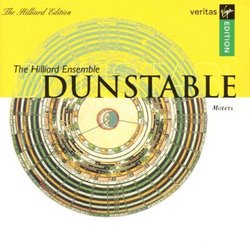| All Artists: The Hilliard Ensemble, Paul Hillier Title: John Dunstable: Motets / Hilliard Ensemble Members Wishing: 1 Total Copies: 0 Label: Angel Records Release Date: 5/20/2000 Album Type: Import Genre: Classical Styles: Opera & Classical Vocal, Chamber Music, Historical Periods, Classical (c.1770-1830), Early Music Number of Discs: 1 SwapaCD Credits: 1 UPC: 724356134225 |
Search - The Hilliard Ensemble, Paul Hillier :: John Dunstable: Motets / Hilliard Ensemble
 | The Hilliard Ensemble, Paul Hillier John Dunstable: Motets / Hilliard Ensemble Genre: Classical
|
Larger Image |
CD Details |
CD ReviewsA capella mystical motets Leslie Richford | Selsingen, Lower Saxony | 11/04/2004 (4 out of 5 stars) "The anonymous author of the liner notes emphasizes quite rightly the 'otherness' of this music, which he sees as more nearly related to non-Western and minimalistic music than to the music of the Renaissance or the Baroque. These isorhythmic motets by the English composer John Dunstable, who lived from approx. 1390 to 1453 and about whose biography very little is known, very definitely have their roots in the mediaeval period, despite certain developments towards modernity which made this composer famous throughout Europe (he is generally cited as having inspired Dufay). In most cases the individual voices sing not only differing melodies but also differing sacred lyrics, the melodies in no way reflecting the meaning of the sung text. This, obviously, makes listening, even when using the texts printed in the accompanying booklet, quite a difficult procedure. Most hearers will, for that reason, probably be satisfied with just listening to the beautifully intermingling male voices, dominated as usual with the Hilliards by the two countertenors, David James and Ashley Stafford, without trying to attend to the lyrics or even to the mysterious mathematical symbolism for which Dunstable is famous. The engineering of the disc tends to promote this. The analogue recording was made at England's Boxgrove Abbey in 1982 and suffers somewhat from a certain amount of noise from the tapes as well as under the (presumably deliberately chosen) echoing church acoustics, which make exact listening even more difficult than it would have been anyway. But perhaps this is just what was intended: even in those days, the Hilliards had a tendency to 'mysticize', an aspect of their art which has, of course, grown with the years. Personally, I would have welcomed a recording of the clarity and quality of their Machault mass for Hyperion. The fact that the Hilliards do without any instrumental accompaniment and sing a capella from start to finish is probably historically accurate and for my mind a big advantage, especially as I must emphasize that each individual singer here has perfect intonation and fits in to the whole beautifully. The repertoire value of the disc is absolutely unquestionable." Medieval Mysteries Geoffrey Waters | Australia | 12/23/2008 (5 out of 5 stars) "Gustav Reese, the erudite but approachable American musicologist got it right. In his two books, "Music in the Middle Ages" and "Rennaisance Music", he describes the Dunstable motet "Veni sanctu spritu" as the most listenable of its genre from the Middle Ages. He describes how Dunstable has overcome the usual problems of this type of motet: that they composed on a strict mathmatical formula, or "isorhyhmic" structure, and have three different Latin texts- so often ending up as esoteric but not very listenable compositions.
However listening to this recording, despite the strict compositional structures, Dunstable gives each line oppurtunity to be clearly declaimed. A testament also to the art of the Hilliard ensemble's singing. The music is all the more accessable to modern listeners because Dunstable pioneers the use of parallel thirds and sixths, as opposed to the usual medieval use of the more "strident" fifths and fourths. So much for the Medieval ear, which was trained to hear thirds/sixths as "dissonant" and fifths and fourths as "harrmonious"- this largely based on the all pervasive religioius and musicological doctrines of the time. In the first edition of Reese's book, he devotes a whole double page spread of the complete score of Dunstable's "Quam pulcra es" ("Song of Solomon"). He argues that this piece bridges the gap, and is the connecting point between Medieval and Rennaissance harmony. So it was Reese who whet my appatite to seek out recordings of Dunstable's music, the above two items in especial. To my delight, there they both were in the original Hilliard LP of the 1980's. Now we have the opportunuty to accessthis re-release on CD- don't let the opportunity slip by. Even now, I tend to savour the tracks one at a time, rather than a staight through listen to the whole CD. In this way one can savour the subtlties of each composition, and the exquisite performance of them. It is a musical language of another era, and another mind-set, yet so intriguingly listenable for us now." |

 Track Listings (9) - Disc #1
Track Listings (9) - Disc #1